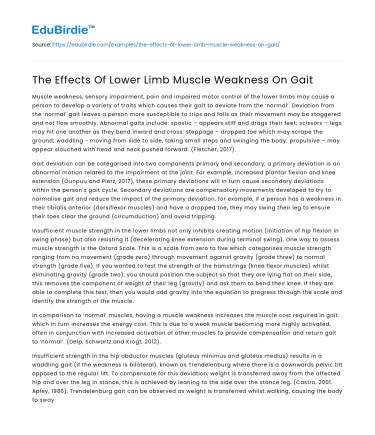Muscle weakness, sensory impairment, pain and impaired motor control of the lower limbs may cause a person to develop a variety of traits which causes their gait to deviate from the ‘normal’. Deviation from the ‘normal’ gait leaves a person more susceptible to trips and falls as their movement may be staggered and not flow smoothly. Abnormal gaits include: spastic – appears stiff and drags their feet; scissors – legs may hit one another as they bend inward and cross; steppage – dropped toe which may scrape the ground; waddling - moving from side to side, taking small steps and swinging the body; propulsive – may appear slouched with head and neck pushed forward. (Fletcher, 2017).
Gait deviation can be categorised into two components primary and secondary, a primary deviation is an abnormal motion related to the impairment at the joint. For example, increased plantar flexion and knee extension (Õunpuu and Pierz, 2017), these primary deviations will in turn cause secondary deviations within the person’s gait cycle. Secondary deviations are compensatory movements developed to try to normalise gait and reduce the impact of the primary deviation, for example, if a person has a weakness in their tibialis anterior (dorsiflexor muscles) and have a dropped toe, they may swing their leg to ensure their toes clear the ground (circumduction) and avoid tripping.
Save your time!
We can take care of your essay
- Proper editing and formatting
- Free revision, title page, and bibliography
- Flexible prices and money-back guarantee
Insufficient muscle strength in the lower limbs not only inhibits creating motion (initiation of hip flexion in swing phase) but also resisting it (decelerating knee extension during terminal swing). One way to assess muscle strength is the Oxford Scale. This is a scale from zero to five which categorises muscle strength ranging from no movement (grade zero) through movement against gravity (grade three) to normal strength (grade five). If you wanted to test the strength of the hamstrings (knee flexor muscles) whilst eliminating gravity (grade two), you should position the subject so that they are lying flat on their side, this removes the component of weight of their leg (gravity) and ask them to bend their knee. If they are able to complete this test, then you would add gravity into the equation to progress through the scale and identify the strength of the muscle.
In comparison to ‘normal’ muscles, having a muscle weakness increases the muscle cost required in gait which in turn increases the energy cost. This is due to a weak muscle becoming more highly activated, often in conjunction with increased activation of other muscles to provide compensation and return gait to ‘normal’. (Delp, Schwartz and Krogt, 2012).
Insufficient strength in the hip abductor muscles (gluteus minimus and gluteus medius) results in a waddling gait (if the weakness is bilateral), known as Trendelenburg where there is a downwards pelvic tilt opposed to the regular lift. To compensate for this deviation, weight is transferred away from the affected hip and over the leg in stance, this is achieved by leaning to the side over the stance leg. (Castro, 2001. Apley, 1986). Trendelenburg gait can be observed as weight is transferred whilst walking, causing the body to sway from side to side.
During loading response in gait, the knee is flexed to absorb impact and transfer weight smoothly from leg to leg. If a weakness is present within the quadriceps (knee extensors) then the ability to counteract the external flexion moment will be lost, producing excessive levels of flexion which may cause the person to adopt a crouched gait. An instability within the knee joint can also be observed, often feeling as though the knee may not support them and give way. To prevent the knee from collapsing, the gluteus maximus and soleus muscles are more highly activated to compensate for the quadriceps weakness and to maintain forward progression. Another counteractive measure to prevent falling is to bend at the hip, leaning forward and shifting the centre of gravity forward, this puts the ground reaction force anterior to the knee causing it to go into hyperextension.
The push off propulsion produced by the gait cycle (heel off/toe off) propels the body forward and enables it to walk efficiently. If a person has weak soleus and gastrocnemius (plantar flexor muscles) however, then none of the forward propulsion is produced resulting in a shorter step length and slower steps. Weakness of the plantar flexors can mean an absence heel off as they do not have the ability to lift the heel. This in turn, causes premature stepping of the other leg with increased knee flexion to compensate for the weak muscles legs foot still being in contact with the floor.
Disease can be another key factor contributing the muscle weakness in the lower limbs, one example in which gait is effected is multiple sclerosis. A common feature of the disease is a dropped toe (steppage gait) due to weakened tibialis anterior (dorsiflexor muscles). This means that there is reduced toe clearance so it may drag on the floor, greatly increasing the risk of injury due to falling. (MS Trust, 2018). Ways in which people with MS may alter their gait is by increasing hip and knee flexion to raise the knee higher than usual to lift the dropped toes or if they also have weakness in their knee flexors then they may swing their leg to the side in a circular motion, known as circumduction and maintain ground clearance, reducing the risk of falling. (Knarr, Reisman, Binder-Macleod and Higgenson, 2013). These compensatory measures would be classed as secondary deviations. Another component which is often produced is an audible foot slap as the muscles are not strong enough to control the rate at which the foot contacts the ground, resulting in it slapping down.






 Stuck on your essay?
Stuck on your essay?

